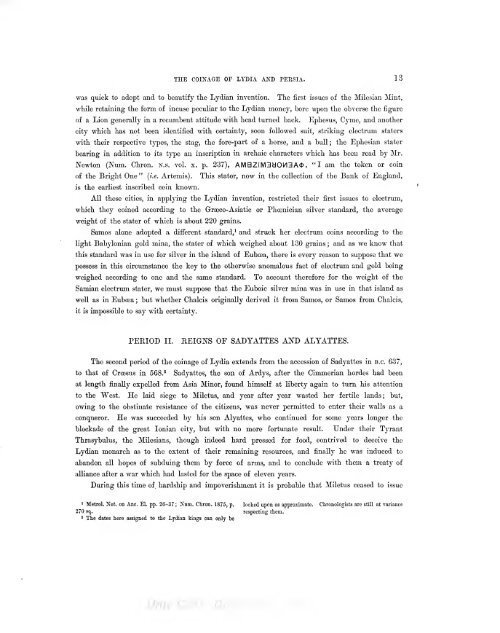NUMISMATA ORIENTALIA. - Forvm Ancient Coins
NUMISMATA ORIENTALIA. - Forvm Ancient Coins
NUMISMATA ORIENTALIA. - Forvm Ancient Coins
Create successful ePaper yourself
Turn your PDF publications into a flip-book with our unique Google optimized e-Paper software.
THE COINAGE OF LYDIA AND PERSIA. 13<br />
was quick to adopt and to beautify the Lydian invention. The first issues of the Milesian Mint,<br />
while retaining the form of incuse peculiar to the Lydian money, bore upon the obverse the figure<br />
of a Lion generally in a recumbent attitude with head turned back. Ephesus, Cyme, and another<br />
city which has not been identified with certainty, soon followed suit, striking<br />
electnmi staters<br />
with their respective types, the stag, the fore-part of a horse, and a bull; the Ephesian stater<br />
bearing in addition to its type an inscription in archaic characters which has been read by Mr.<br />
Newton (Num. Chron. n.s. vol. x. p. 237), AIViaZIM3dOH3A0, "I am the token or coin<br />
of the Bright One " (i.e. Artemis). This stater, now in the collection of the Bank of England,<br />
is the earliest inscribed coin known.<br />
All these cities, in applying the Lydian invention, restricted their first issues to electrum,<br />
which they coined according to the Graeco-Asiatic or Phoenician silver standard, the average<br />
weight of the stater of which is about 220 grains.<br />
Samos alone adopted a difierent standard,' and struck her electrum coins according to the<br />
light Babylonian gold mina, the stater of which weighed about 130 grains ;<br />
and as we know that<br />
this standard was in use for silver in the island of Euboea, there is every reason to suppose that we<br />
possess in this circumstance the key to the otherwise anomalous fact of electnmi and gold being<br />
weighed according to one and the same standard. To account therefore for the weight of the<br />
Samian electnmi stater, we must suppose that the Euboic silver mina was in use in that island as<br />
well as in Euboea ; but whether Chalcis originally derived it from Samos, or Samos from Chalcis,<br />
it is impossible to say with certainty.<br />
PERIOD II. REIGNS OF SADYATTES AND ALYATTES.<br />
The second period of the coinage of Lydia extends from the accession of Sadyattes in B.C. 637,<br />
to that of Croesus in 568.* Sadyattes, the son of Ardys,<br />
after the Cimmerian hordes had been<br />
at length finally expelled from Asia Minor, found himself at liberty again to turn his attention<br />
to the West. He laid siege to Miletus, and year after year wasted her fertile lands; but,<br />
owing to the obstinate resistance of the citizens, was never permitted to enter their walls as a<br />
conqueror. He was succeeded by his son Alyattes, who continued for some years longer the<br />
blockade of the great Ionian city, but with no more fortunate result. Under their Tyrant<br />
Thrasybulus, the Milesians, though indeed hard pressed for food, contrived to deceive the<br />
Lydian monarch as to the extent of their remaining resources, and finally he was induced to<br />
abandon all hopes of subduing them by force of arms, and to conclude with them a treaty of<br />
alliance after a war which had lasted for the space of eleven years.<br />
During this time of hardship and impoverishment it is probable<br />
that Miletus ceased to issue<br />
• Metrol. Not. on Anc. EL pp. 26-37 ; Num. Chron. 1875, p. looked upon as approximate. Chronologists are still at yariance<br />
270 sq. respecting them.<br />
' The dates here assigned to the Lydian kings can only bo

















